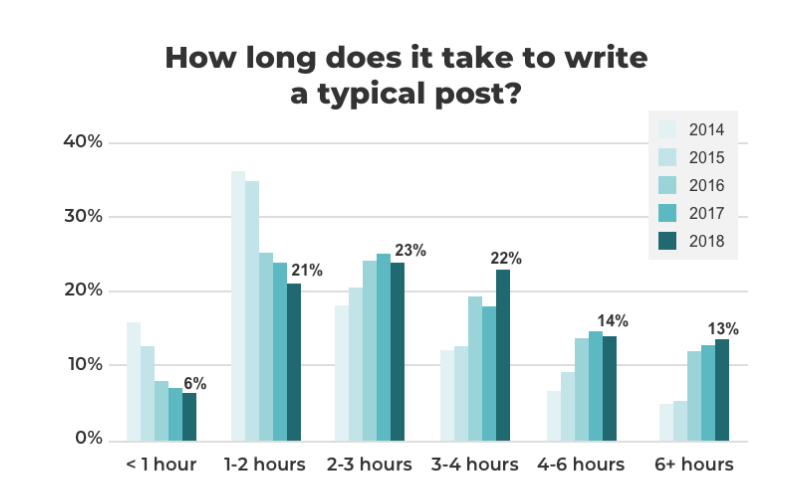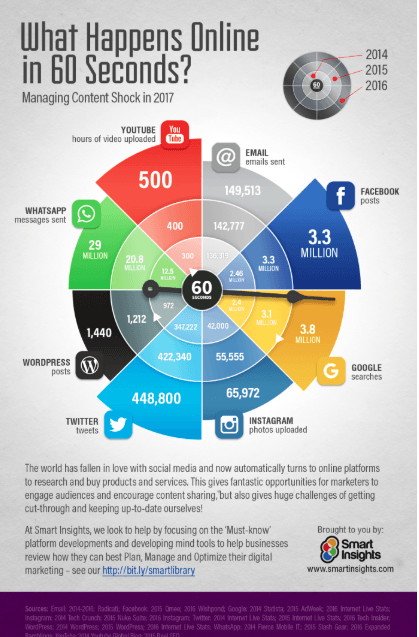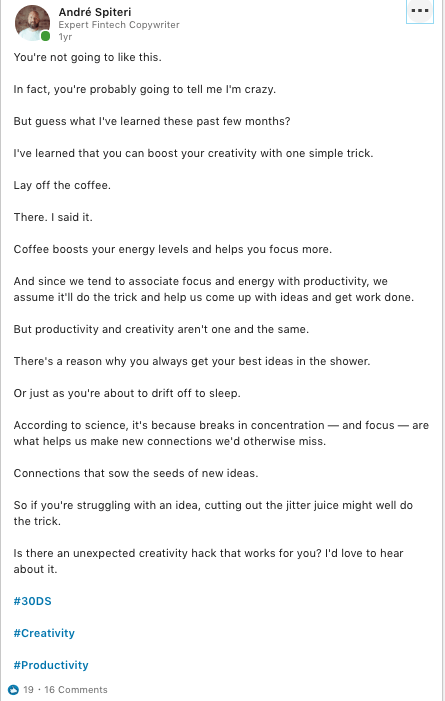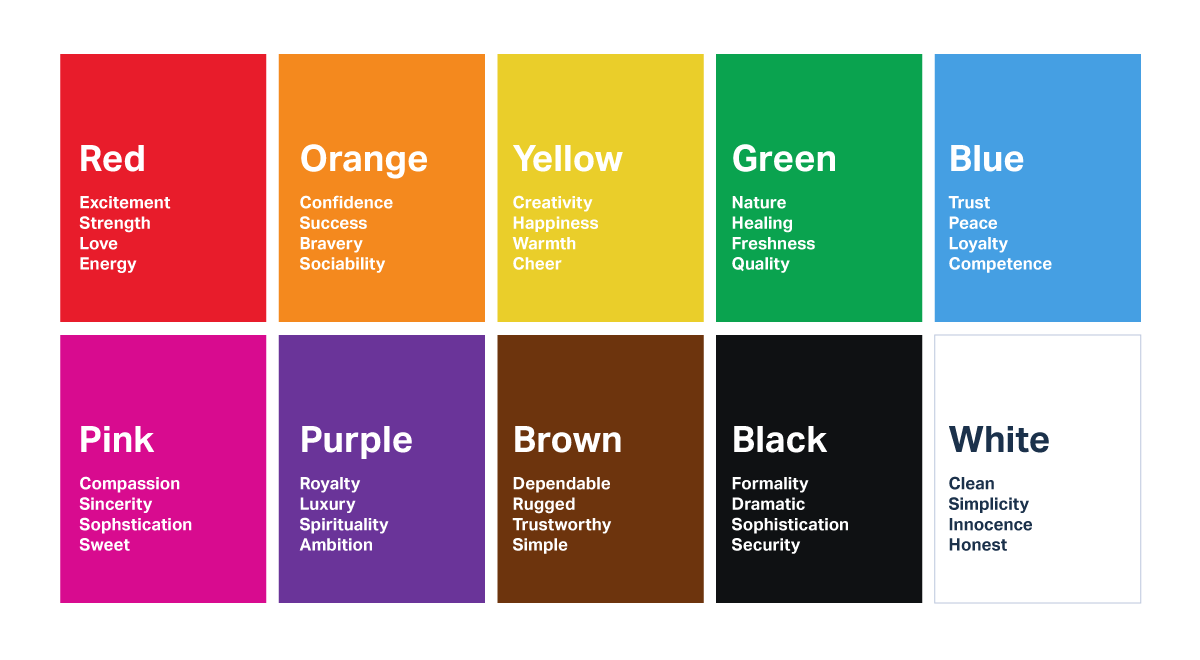Waste not want not: why you should repurpose your content (and how to do it)
Blog
Is your content delivering as much value as it possibly can?
If you don’t repurpose it, it probably isn’t.
It takes 3 hours and 28 minutes, on average, to write a blog post. And much longer for more in-depth posts.

Source: Orbit Media Studios
That’s a lot of time and effort (and tea and biscuits). So it makes sense to extract every last drop of value from each piece you craft.
Right?
Well, that’s exactly what repurposing your content helps you do.
What is repurposing?
Let’s start at the beginning. Repurposing means changing the format of an existing piece of content so it reaches a new audience. This could be a subset of your target audience or a different audience altogether.
Let’s say you have a blog post about budgeting geared at uni students.
You could repurpose this into a YouTube video. This way, you’d reach uni students who prefer videos over reading.
But you could also repurpose it into a mini-course about budgeting. This would target uni students who want to delve deeper into the topic. At the same time, you might also reach career coaches and counsellors who want to give their students better advice.
5 compelling reasons to repurpose your content
So far so good.
That said, you might be asking yourself:
“What of it? I’ve already written about budgeting for students. Why spend time and effort repurposing it when I could work on something new?”
Well, for five excellent reasons.
1. To broaden your audience
The more people your content appeals to, the more eyeballs it’ll get. That means more traffic, more engagement, more leads and, ultimately, more of that sweet, sweet moolah.
Blog posts are the most popular type of content marketing. And there’s no doubt they’re effective. In 2018, 71% of B2B buyers engaged with blog content before pulling the trigger on a purchase. And websites with regularly updated blogs get 55% more traffic than ones that don’t have one.
But that doesn’t mean everyone reads blogs. Some people are visual learners. They prefer watching videos or seeing data graphically. And some prefer listening to podcasts.
Even those who do read your blog might not be giving it their full attention. 43% of those surveyed for Hubspot’s 2019 marketing statistics report, for instance, admitted they skim, rather than read the whole thing.
Repurposing your blog posts means you can get your message in front of people you otherwise wouldn’t reach. And, of course, this works both ways. Repurposing podcasts, videos or other content into blog posts means you can reach those who prefer reading over other formats.
2. It’s good for SEO
Speaking of more eyeballs and more shares, while ex-Googler Mike Cutts has said social media activity isn’t a ranking factor, studies show that content with more social media shares tends to rank better in search results.
To quote Orbit Media’s Andy Crestodina:
Content repurposing can improve SEO through increasing your outreach, attracting mentions from other content creators and improving your chances of outside sources linking to your page.
In other words, repurposing doesn’t just help broaden your audience. It makes you more visible. And greater visibility means more traffic, more shares, more people linking to your content and, so better search engine rankings.
3. You can do more with less
In her book Lean Content Marketing (if you haven’t read it, you should grab a copy) Jo Duncan recommends getting off the hamster wheel and being more intentional with your content marketing efforts.
“The current landscape of content marketing,” she says, “is geared towards quantity over quality.” But it should be the other way round.
Repurposing the content you already have takes away the pressure of constantly having to come up with new ideas and churning out content that might be half-baked. Instead, you can focus on fleshing out the really good ideas, making them the best they can be and getting them in front of as many people as possible.
4. What works on one channel may not work on another
Case in point, sharing links to your blog posts on LinkedIn doesn’t usually get good results, because the algorithm penalises external links. It’s usually better to repurpose your message as a LinkedIn post (or as a video, if you’re not camera-shy).
Similarly, unless they’ve attended your talk, there’s a good chance your audience will have a hard time understanding your presentation slides. A write-up or a recording would probably deliver better results.
5. To breathe new life into an old piece
Not every piece of content you create will do well. Sometimes, your content just won’t resonate with people at the time you publish it. Or, perhaps, it’ll get lost in the clutter. Which is perfectly understandable, seeing as 211 million pieces of content hit the internet every minute.

Source: eJenn Solutions
Repurposing is a great way of pulling out content that, for some reason, has ended up at the back of the shelf, reframing it and giving it a new lease of life.
7 brilliant content repurposing ideas
So you’re on board with the idea of repurposing content.
Now what?
Here are seven ideas you can try.
1. Rework old content
OK, so this isn’t strictly repurposing. But it’s still well worth the effort.
To be clear, I’m not suggesting you make minor tweaks, slap a shiny new graphic and press share. That would be like putting lipstick on a pig.
What I’m talking about is updating, expanding and improving an existing piece of content so it’s more comprehensive, more relevant and more useful to your audience.
This is good for three reasons:
You’ll breathe new life into something that’s possibly a bit lackluster
If the content underperformed when you originally published it, reworking it can give it a better chance of doing well
It’ll improve the piece’s search ranking
The key is to know which content is worth revamping and which is best left alone. Moz suggest asking yourself the following questions:
Is the content beneficial to your audience? In other words, will it help, educate or entertain them?
Is it beneficial to you? It’s beneficial if it’s the type of content that will attract your ideal customer. Your ideal customer can change over time, so the answer isn’t always straightforward. For example, while you might have been pushing your blog writing services in 2016, you may have now decided to focus on white papers. So revamping content you’ve created to promote your blogging services might no longer be beneficial
Could you improve on what you currently have? Perhaps the content in its current form is poorly structured. Or maybe you’ve gained new insights or even changed your opinion on a point you’d made
2. Compile an ebook
Have several blog posts that are related to each other, for example because they tackle different aspects of the same topic?
You could collect them in an ebook and give it out for free to people who sign up to your mailing list.
You’ll need to design an appealing layout. But other than that, if you pick your posts wisely, you’ll only have to do minimal tweaking, such as adding an introduction and conclusion and, possibly, reordering a few paragraphs.
You don’t have to make your ebook available just as a .pdf download, either.
Why not make it available as a free download on multiple platforms, like Kindle or Apple’s iBooks?
3. Flesh out a series of blog posts into an online course
A series of related blog posts can make a great starting point for an online course. You’ll need to expand them so they go into more detail and add actionable steps — or ‘homework’ if you like — that users can do before going on to the next part.
You could send the course out one section at a time to email subscribers as part of a lead nurturing sequence. Or you could sell it on Udemy or Skillshare and generate passive income.
Here’s an excellent guide from ProBlogger’s Darren Rowse on creating a successful online course.
4. Turn a blog post into bite-sized social media posts
The idea is to break down a longer piece of content into a series of bite-sized tidbits and share them as individual social media posts your audience can consume in three minutes or less.
This works especially well on LinkedIn, which doesn’t like external links. For instance, back in April 2016, I wrote a blog post about productivity hacks for freelance creatives. And the first hack was “lay off the coffee”.
Here’s an excerpt from the original post:
Coffee does boost your energy levels and help you focus more. And since we tend to associate focus and energy with productivity, we assume coffee will do the trick and help us get work done.
Creativity, however, isn’t just about being productive. It’s about the ability to link ideas and concepts in ways that were previously unthought of. And – you guessed it – your mind is better at making these connections when it’s unfocused.
In fact, there’s a case to be made that focus is downright bad for creativity. Which kind of explains why you always seem to get your best ideas in the shower, or when you’re just about to drift off to sleep.
I turned that into this LinkedIn post:

But breaking down a longer piece of content into bite-sized pieces also works well on Twitter, Instagram, Facebook or wherever else your business lives online, because your audience sees one, self-contained, easy-to-digest idea that doesn’t require any effort to consume.
5. Create an infographic
Your social media followers are 94% more likely to see your content if it contains relevant images. Add in the fact that infographics are shared three times more often than other types of content, and you can see why they should form part of your content mix.
A tool such as Canva or Piktochart (designer friends, please don’t shoot) can help you create a slick-looking infographic for free in just a few minutes.
That said, you’ll need to put some careful thought and planning into the actual content of the infographic.
Here are three tips:
Keep it concise. While you don’t want to be superficial, you’re not writing the sequel to War and Peace either
Use colour to set the tone (see image below)
Tap into your audience’s emotions. For example, Copyblogger’s 15 Grammar Goofs uses humour to hammer the point home without being condescending

Source: UserTesting Blog
6. Make a video
There’s no doubt that video marketing is booming. 78% of people watch at least one video a week. And 59% of executives say they’d rather watch a video than read text.
Video is also incredibly effective on social media. On LinkedIn, for instance, videos get three times as much engagement as text-only posts. Similarly, tweets with video get ten times more engagement than text-only tweets.
With numbers like these, it makes sense to repurpose your blog posts as videos.
If you’re comfortable in front of the camera, you could talk to your audience directly. Emma Cownley does this brilliantly.
But if you’re camera-shy, that doesn’t mean video is out of the question. For example, Megan Rose repurposed her excellent 10 Things Every Freelancer Knows blog post into this fantastic video using only images with equally good results.
Meg told me:
The video gave the content a whole new lease of life (and a whole new audience), pretty much doubling the exposure the original had generated. Since then, I’ve been using the same format for a few other bits, including some of my testimonials, and they get loads of engagement too.
7. Record a podcast
If anything’s hotter than video right now, it’s podcasts.
6 million Brits tune in to a podcast at least once a week. And, more significantly, 38% listeners will buy a product or service featured on that podcast.
The biggest appeal of podcasts is that they’re so easy to fit into a busy lifestyle. People can listen to podcasts during their morning commute, while they work out or even while they’re working or doing housework.
Unsurprisingly, podcast listeners tend to be more loyal than other audiences. Where 43% of blog readers skim blog posts, 80% of podcast listeners listen to all — or most — of each podcast episode they tune in to.
If you have several pieces of long-form content, one piece can span several episodes. But you could also make an episode per piece. It really depends on what you have.
As for format, the solo commentary — or solo-cast — where you speak directly to the audience for the duration of the episode, is a good option. That said, it may be worth considering a Q&A with a guest around the topic or even a panel discussion. This will add more depth and bring different perspectives.
Want more info about starting your own podcast? Doing It For The Kids and Being Freelance host Steve Folland shared several golden nuggets of podcast wisdom on the AllGoodCopy podcast.
Wrapping up
It’s safe to say we’ve reached peak content overload. Customers are constantly bombarded with marketing messages. At the same time, many businesses feel like they have to keep churning out content just to carve out a small space for themselves in the conversation.
Well, with a repurposing strategy in place, you can stop the churn and put your focus back on quality over quantity. Which is where it belongs. Adapting one piece of content into several different formats will help you get as much value out of your ideas as possible and reach people who’d never hear about you otherwise with less stress.
Why work hard when you can work smart?
Got other content repurposing ideas, tips or tricks I’ve missed? Let me know in the comments section or tweet at me.